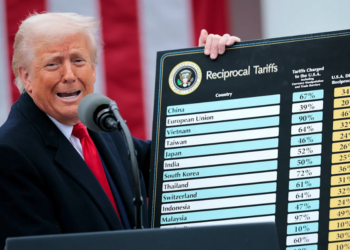The United States swung into a $576 million trade surplus with Nigeria in the first half of 2025, reversing a deficit of $779 million in the same period of 2024.
Fresh data from the U.S. Census Bureau and the Bureau of Economic Analysis reveal that stronger American exports into Nigeria and weaker Nigerian shipments to the U.S. powered the reversal.
This marks a significant turnaround in U.S.–Nigeria trade relations, driven largely by higher American exports into the Nigerian market and a moderation in imports from Africa’s biggest crude exporter.
Nigeria flips from deficit to surplus
The turnaround in U.S.–Nigeria trade is striking. Between January and June 2025, U.S. exports to Nigeria rose by 41% year-on-year, climbing from $2.36 billion in H1 2024 to $3.34 billion in H1 2025. Imports moved in the opposite direction, falling 12% from $3.14 billion to $2.76 billion. This swing of more than $1.3 billion transformed Nigeria from a deficit position to a net surplus partner for Washington.
The June monthly figures highlight the sharpness of this shift. U.S. exports to Nigeria surged to $919 million, up 196% from $310 million in June 2024. Imports grew more modestly, up 29% from $493 million to $639 million in the same period. Consequently, the monthly balance flipped from a $182 million deficit in June 2024 to a $280 million surplus in June 2025.
Behind the trend is Nigeria’s growing reliance on U.S. manufactured goods—ranging from machinery and vehicles to pharmaceuticals—at a time when foreign exchange scarcity continues to choke local production.
Africa still drains U.S. balance despite surplus against Nigeria
Nigeria’s reversal did little to alter the broader story of U.S.–Africa trade. The continent as a whole still posted a deficit of $3.69 billion against the U.S. in the first half of 2025, slightly worse than the $3.61 billion deficit in the same period of 2024.
- While American exports to Africa jumped 29%, from $15.2 billion in H1 2024 to $19.7 billion in H1 2025, imports rose even faster. They increased by 24%, from $18.9 billion to $23.4 billion, outpacing exports in absolute terms and maintaining Africa as a net drain on U.S. trade books.
- The shift in Nigeria’s balance therefore stands out. Only Egypt and Nigeria gave Washington surpluses in 2025, together contributing over $3.3 billion in positive balances. However, these gains were not enough to offset deep deficits elsewhere, especially with South Africa and Algeria.
The regional picture suggests that while U.S. goods are penetrating African markets more effectively, the continent’s commodity exports still outweigh U.S. shipments.
Nigeria versus peers
Comparing Nigeria’s performance to its African peers reveals diverging outcomes. Egypt posted the largest African surplus for the U.S. at $2.73 billion in H1 2025, more than doubling the $1.31 billion surplus in 2024. U.S. exports to Egypt grew 63% from $2.55 billion to $4.16 billion, while imports rose only 15%, from $1.24 billion to $1.43 billion, tilting the balance heavily in Washington’s favour.
South Africa moved in the opposite direction. America’s deficit with the country almost doubled, widening from $3.38 billion in H1 2024 to $6.32 billion in H1 2025. Imports surged by 52%, from $6.24 billion to $9.50 billion, while exports inched up only 11%, from $2.86 billion to $3.18 billion. This imbalance makes South Africa Washington’s most challenging African trade partner.
Algeria remained negative but slightly improved, narrowing its deficit from $844 million in 2024 to $571 million in 2025, largely due to a modest rise in U.S. exports and a drop in imports. Meanwhile, the “Other Africa” category reversed a $77 million surplus in 2024 to a $108 million deficit this year.
What you should know
The shift in America’s trade balance with Nigeria comes against the backdrop of new U.S. tariff measures on African partners. Beginning August 7, 2025, Washington implemented “reciprocal tariffs” under a revised schedule that set Nigeria’s country rate at 15%.
- While Nigeria previously faced a 14% tariff under the April “Liberation Day” order, the revised rate formalised the adjustment.
- South Africa and Algeria were each assigned 30%, while Egypt remained at the 10% baseline, with its Qualifying Industrial Zone (QIZ) exports still enjoying duty-free access.
- These tariffs add to existing most-favoured-nation duties and are designed to mirror restrictions faced by U.S. goods in the affected markets.
The move has heightened pressure on resource-driven exporters like Nigeria and Algeria, while widening America’s imbalance with South Africa in metals and autos. By contrast, Egypt’s position has been more resilient, as its diversified exports and QIZ framework insulate key sectors from the steepest tariff impacts.























